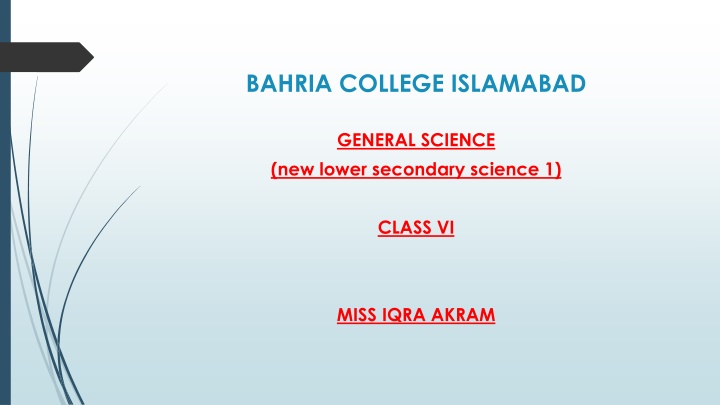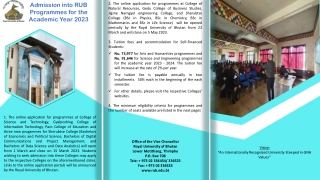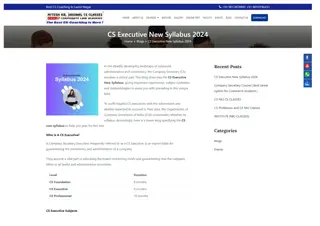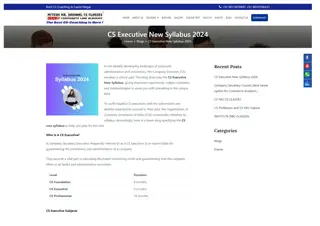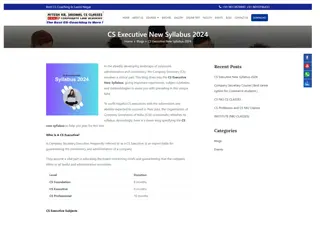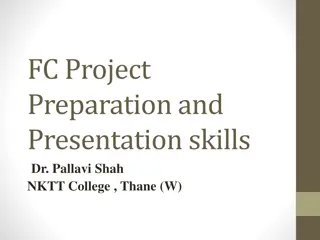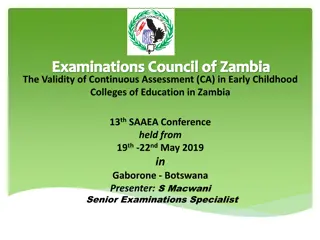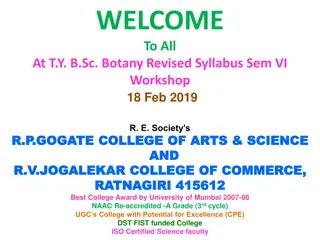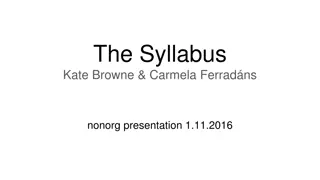Bahria College Islamabad General Science - Class VI Syllabus Overview
Explore the first term syllabus for Class VI General Science at Bahria College Islamabad, covering topics like Time, Rate, Speed, Living in a Changing World, Manufacturing, and the dangers of Smoking. Delve into units focusing on measuring time, speed equations, sundials, stop clocks, and types of stopwatches. Gain insights into instruments used to measure time, historical facts about sundials, and the differences between mechanical and electronic stopwatches.
Download Presentation

Please find below an Image/Link to download the presentation.
The content on the website is provided AS IS for your information and personal use only. It may not be sold, licensed, or shared on other websites without obtaining consent from the author.If you encounter any issues during the download, it is possible that the publisher has removed the file from their server.
You are allowed to download the files provided on this website for personal or commercial use, subject to the condition that they are used lawfully. All files are the property of their respective owners.
The content on the website is provided AS IS for your information and personal use only. It may not be sold, licensed, or shared on other websites without obtaining consent from the author.
E N D
Presentation Transcript
BAHRIA COLLEGE ISLAMABAD GENERAL SCIENCE (new lower secondary science 1) CLASS VI MISS IQRA AKRAM
FIRST TERM SYLLABUS UNIT 3: Time, Rate and Speed UNIT 7: Living in our changing world UNIT 8: Manufacturing- From Raw material to useful products UNIT 24: Smoking Kills
UNIT 3: Time, Rate and Speed pg#32 About time and its unit of measurement How to use measuring instrument? Eg stopwatch & stop clock Meaning of rate & speed and its unit of measurement. How to measure speeds of moving object. Speed equation and its use in real life situations.
3.1#Time pg#33 QNO1: Define time. plan, schedule, or arrange when (something) should happen or be done is known as Time. QNO1(a): Which instruments are commonly used in the laboratory for measuring time? Watches and clock tell us the time of the day. Before invention of watches and clocks , people relied on the sun, the moon and the stars to Keep time. The SI unit of time is the second (S). Other units for time include minutes (min), hours (h), days, month, years, decades and centuries.
Science tidbits on pg #33 QNO2:what do u know about sundial? The sundial was first made by the Egyptians in the year 800 B.C. The sun cast a shadow on the face of sundial and the position of shadow on a scale gives the time.
Stop clock pg#34 QNO3:what do u know about stop clock? The stop clock has a clock face with sixty divisions, each represents a time interval of one second. The long red hand shows the number of seconds Shorter white hand shows the number of minutes. 60 min and 19 sec.
QNO4: What are the types of stop watch? pg#34&35 There are two types of stop watch : 1. mechanical stopwatch 2. digital/ electronic stopwatch.
Qno4: write difference between mechanical and electronic stopwatch? Electronic stopwatch The electronic stopwatch gives higher accuracy than a mechanical stopwatch. Mechanical stopwatch The mechanical stopwatch consist of a minute scale and a second scale. The minute scale is seen as a smaller circle at the top of the face of the stop watch. The second scale is seen as the big circle on the face of the stopwatch. Minute hand is small and second hand is large. It has a digital display of the time . It can measure time interval accurate to 0.01s. It can also record time intervals in hours.
Topic: Rate pg#36 QNO6: Define rate. ANS: Rate: Rate is the ratio between two quantities. It describes how a quantity changes with another. For example : Rate of petrol consumption The rate of petrol consumption is the distance travelled by a car for every unit of petrol consumed. Rate of petrol consumption= Distance travelled ---------------------------- Amount of petrol used
Qno6: the rate of petrol consumption of Ming Chuns car is 12km/l. How much is needed for the car to travel 60 km? Pg.# 36 Data: rate of petrol consumption= 12km/l Distance travelled= 60 km. Amount of petrol needed = ? Solution: Rate of petrol consumption= distance travelled Amount of petrol needed 12km/l = 60km Amount of petrol needed Then multiply amount of petrol needed on both sides.
Topic: speed pg=39 QNO7: Define Speed . Ans : speed is the rate of change of distance with time or the distance travelled per unit time. Units for speed: The SI unit for speed is meter per second (m/s ). Other common units for speed include km/h and cm/s.
Average speed the average speed is equal to the total distance travelled divided by the total time taken to travel distance.
Review Questions Pg#42 QNO1(a): Which instruments are commonly used in the laboratory for measuring time? Ans : Mechanical and electronic stopwatch are used in laboratory for measuring time accurate to 1s. QNO1( b): Write down the units of time measured by these instruments? Ans : The SI unit of time is the second (S).Other units for time include minutes (min),hours (h), days, month, years, decades and centuries. QNO2.( a) what is meant by rate ? ANS: Rate: Rate is the ratio between two quantities. It describes how a quantity changes with another.
QNO2.( b)which of the following is not a rate? a. Speed b. power c. rate of volume flow d. time QNO3: which car can travel the longest distance with 10l of petrol? The car with a rate of petrol consumption of ________. a. 8km/l b. 10km/l c. 12km/l d. 15km/l
QNO4: Define speed and write down its SI unit. Ans: See slide no 12 QNO5: what is difference between instantaneous speed and average speed? Instantaneous speed Average speed It is a speed of an object with respect to an observer in a very short time .It is better to say it is the speed of an object at a moment The average speed is equal to the total distance travelled divided by the total time taken to travel distance.
QNO6: A bus took 2h travel from one terminal to another at an average speed of 40km/h. what is the total distance travelled by the bus? DATA:
